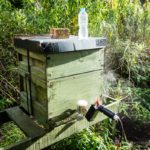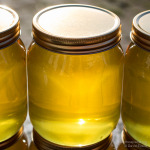Miticide cost effectiveness
My recent comments on the cost of Api-Bioxal prompted me to look in a little more detail at the cost of miticides routinely available to beekeepers. The figures quoted below are the best prices listed by one of three leading beekeeping suppliers in the UK (E.M. Thorne, Maisemore’s (no longer trading) and C. Wynne Jones – there are lots of other suppliers, but I’ve used these three and been satisfied with their service). I made the following assumptions: the beekeeper is purchasing sufficient to treat three single-brooded full colonies for three years (i.e. something with a reasonable shelf-life) with as little left over as possible. Costs per colony treatment were calculated for 9 colonies (3 x 3 years) only … any ‘spare’ can therefore be considered as free. This means that for Apiguard, available in packs of ten trays (5 colony treatments) or a 3kg tub (30 colonies), the cost is calculated per colony from two packs of 10 trays as a full course of treatment for one colony requires two trays. Obviously, buying in bulk – for example through a co-operative purchasing scheme in your beekeeping association – should reduce these costs significantly. No postage costs were included.
Apiguard – two boxes of 10 trays (C. Wynne Jones) = £41 = £4.55/colony
Apistan – two packs of 10 strips (C. Wynne Jones) = £41 = £4.55/colony
MAQS – one 10 dose tub (all suppliers) = £57.60 = £6.40/colony
Api-Bioxal – one 35g sachet (C. Wynne Jones) = £8.20 = £0.91/colony
Oxalic acid (OA) crystals – one 300g tub (Maisemore’s) = £4.32 = £0.48/colony
Note that this simplistic comparison hides a number details.
- These various treatments should be broadly similar in their efficacy (see below) in reducing the mite population, but must be used according to the manufacturers instructions for maximum efficiency. Under optimal conditions all quote at least 90% reduction in mite levels. However, Apistan (and Bayvarol, not listed) is pyrethroid-based and resistant mite populations are very widespread. In the presence of totally or partially resistant mites, Apistan will be of little or no benefit. Interestingly, Apistan resistance (which, like resistance to pyrethroids in other species, is due to a single amino acid substitution, so readily selected) appears to be detrimental to the mite in the absence of selection. This means that it may be possible to use Apistan effectively every 3-5 years as part of an integrated pest management as long as other beekeepers in the area follow the same regime. During the years Apistan is not used the pyrethroid-resistant mites should reduce in number, so restoring the efficacy of the treatment. I’m not aware that this idea has been properly tested, but it might be worth investigating.
- Only the first four treatments are approved for use in the UK by the VMD.
- Both the oxalic acid-containing treatments – Api-Bioxal and OA crystals – require preparation before use, or specialised equipment for delivery. OA vaporisation (sublimation) also necessitates both care and personal protection equipment to prevent exposure to the chemical which is a lung irritant. The costs indicated do not include these additional requirements.
- The treatments are not equivalent or necessarily interchangeable. For example, a) only MAQS should be used when honey supers are present, b) Apiguard is moved around the hive by active bees, so treatment is recommended when average daytime temperatures are above 15ºC , and c) there are reports on discussion forums of repeated OA vaporisation treatment – 3 at 5 day intervals – for colonies with brood present. The costs indicated above assume a single treatment (in midwinter or of a swarm/shook swarm in the case of OA) with any of the listed compounds.
- Finally, the ‘excess’ amount spare after treating the colonies over three years differs significantly. The first four have sufficient left over for one further treatment. The OA crystals will have enough left over for a further 190 colonies … and buying a 300g tub is probably about the most expensive way to purchase OA per gram 🙂
Bang for your buck
As indicated above, all of the Varroa treatments listed should give 90+% knockdown in mite numbers if used properly. This means following the manufacturers’ instructions – in terms of dose, time and duration of application. A key point to remember is that the mite is only susceptible when outside the capped cell and that 80% or more of the Varroa in a colony at any one time will be inside capped cells if there is brood present. For this reason, it is preferable to treat during natural (or induced e.g. a shook swarm) broodless periods. It has even been suggested that the midwinter OA treatment should be preceded by destruction of any brood present. Although this makes sense, I can understand why some beekeepers might be reluctant to open a colony to destroy brood in the middle of winter. There have been numerous reviews of individual and comparative efficacy of the various Varroa treatments – for example this well-referenced article on mite treatment in New Zealand from 2008 (no longer available – apologies). If used properly there’s little to choose between them in terms of efficacy, so the choice should be made on the grounds of suitability, convenience and cost.
‘Suitability’ is a bit of a catch-all, but requires you broadly understand how and when the treatment works – for example, Apistan is a pyrethroid so works well against sensitive mites, but is pretty-much useless against resistant populations, and resistance is widespread in the UK. ‘Convenience’ is generally high in the ready-prepared commercial treatments – it takes seconds to insert a tray of Apiguard – and much lower if the compound has to be prepared or you have to get dolled up in protective gear. In this regard, the absence of a pre-mixed liquid version of Api-Bioxal is a disappointment. Thorne’s still supply (at the time of writing) Trickle 2, a very convenient pre-mixed 3.2% w/v OA treatment for mid-winter trickling, but for how much longer? Similarly, the gloves, mask, goggles and power needed to treat a colony by OA sublimation makes it far from convenient for a single treatment.
Closing thought …
Despite the great differences between the cost/treatment/colony it’s worth noting that even the most expensive is not a lot more than the price of a 1 lb jar of top quality local honey … just like the stuff your bees produce 😉 So, in the overall scheme of things, Varroa treatment is relatively inexpensive and very important to maintain colony health and to reduce overwintering colony losses.
See also Managing Varroa published by the Animal and Plant Health Agency


Join the discussion ...